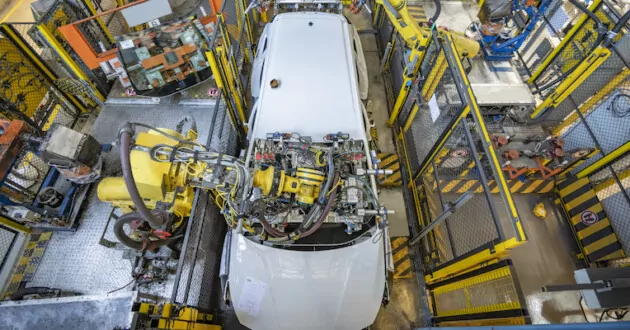
Independent research firm Verdantix recently identified IBM as a leader in their report, “Green Quadrant: ESG Reporting and Data Management Software” (July 17, 2023), which evaluated and provided a detailed assessment of solution providers and their product offerings. The rigorous analysis conducted by Verdantix included a comprehensive 115-point questionnaire, two-hour live demonstrations by suppliers and interviews with existing ESG software customers. The audience surveyed are those who are responsible for selecting, implementing and deriving value from Environmental, Social and Governance (ESG) reporting and data management applications.
The report notes that the market landscape for ESG reporting software and data management software has evolved rapidly over the past three years, driven primarily by increased regulations and interest from a variety of internal and external stakeholders. This has resulted in a proliferation of new entrants to the market seeking to meet a wide range of needs, including collecting and managing large amounts of data, ensuring the data is audit-ready, enabling reporting on that data, and using tools and technology to drive business decisions.
IBM has a strong heritage in helping clients around the world use technology like AI and advanced analytics—including the IBM Envizi ESG Suite and IBM Planning Analytics—to address their sustainability goals. IBM’s sustainability solutions provide clients with an end-to-end solution to manage ESG data, drive performance improvements and address reporting and disclosure requirements.
In reviewing IBM’s capabilities in ESG Reporting and Data Management, the Verdantix report notes that IBM has strengths in:
- Data quality control and enhancement, including “easy-to-understand reports to better analyze data quality. These include incomplete data reports to identify missing or overlapping data at a granular level – such as by supplier or location – tools to automate the collection of missing data, and data health checks that include various metrics like time series meter data.”
- ESG and sustainability performance, including how “Envizi has particular strengths helping firms with long-term sustainability planning, including tracking net zero pathways, allowing users to set assumptions around growth scenarios, and helping customers explore these scenarios so they can make better decisions in how to allocate funding. In addition, IBM offers modelling capabilities through its Planning Analytics Solution, which uses AI and machine learning from the IBM Watson tool to perform what-if analyses and muti-variate forecasting.”
Companies around the globe are using IBM Envizi to simplify the capture, consolidation, management, analysis and reporting of ESG data, including Growthpoint, an Australian real estate investment trust, and Melbourne Water, the Australian government-owned authority that protects and manages major water resources for the city.
This recognition of IBM’s strengths in ESG reporting and data management software complements our leadership rating in the Verdantix “Green Quadrant: Enterprise Carbon Management Software 2022” study. These two results are welcome validation of our position as a leader in the market and encourages us to continue on the path to expand our capabilities in this space and key functionalities of our offerings.
For more information about IBM Sustainability, please visit the IBM sustainability solutions.
Watch IBM’s Sustainability Solutions video
More from Sustainability

Optimizing energy production with the latest smart grid technologies
5 min read – New technologies are shaping the way we produce, distribute and consume energy. Smart grid technology—an integral part of energy’s digital transformation—promises to modernize the traditional electrical system with an infusion of digital intelligence that helps energy providers transition to clean energy and reduce carbon emissions. The U.S. alone has installed nearly 10,000 electricity generation units, connected by more than 300,000 miles of transmission lines and capable of generating over a million megawatts of energy. But the import of smart grid…
5 min read

OEE vs. TEEP: What’s the difference?
4 min read – Breakdowns, equipment failure, outages and other shop floor disruptions can result in big losses for an organization. Production managers are tasked with ensuring that factories and other production lines are getting the most value out of their equipment and systems. Overall equipment effectiveness (OEE) and total effective equipment performance (TEEP) are two related KPIs that are used in manufacturing and production environments to help prevent losses by measuring and improving the performance of equipment and production lines. What is overall…
4 min read

Sustainability in the Age of AI
3 min read – To achieve a step-change in business performance, organizations are combining technology modernization and sustainability into their core business processes. To do this requires improving user support tools that can help business leaders with the increasingly complex decisions needed to optimize across cost, service level, working capital and sustainability. Generative AI is a catalyst for transforming business, and the technology is capturing the attention of business leaders around the world. As CEOs respond and embrace generative AI, they are faced with…
3 min read

CMMS vs. EAM: Two asset management tools that work great together
6 min read – Most organizations can’t run without physical assets. Machinery, equipment, facilities and vehicles provide economic value or benefit operations. In most cases, they are fundamental to the performance of the organization, regardless of whether they are small-scale laptop portfolios or vast transportation networks. Energy companies rely on uninterrupted power supplies, airlines aim to ensure passenger safety, hospitals must provide quality patient care, haulage companies need up-to-date data on spare parts to maintain service levels. Organizations can’t work effectively if they don’t…
6 min read
- SEO Powered Content & PR Distribution. Get Amplified Today.
- PlatoData.Network Vertical Generative Ai. Empower Yourself. Access Here.
- PlatoAiStream. Web3 Intelligence. Knowledge Amplified. Access Here.
- PlatoESG. Automotive / EVs, Carbon, CleanTech, Energy, Environment, Solar, Waste Management. Access Here.
- BlockOffsets. Modernizing Environmental Offset Ownership. Access Here.
- Source: https://www.ibm.com/blog/ibm-named-a-leader-in-esg-reporting-and-data-management-software-by-independent-research-firm/
- :has
- :is
- 000
- 10
- 11
- 12
- 17
- 2023
- 23
- 25
- 28
- 30
- 300
- 31
- 39
- 40
- 46
- 9
- a
- About
- Achieve
- across
- addition
- address
- advanced
- Advertising
- age
- AI
- aim
- Airlines
- All
- allocate
- Allowing
- alone
- amounts
- amp
- an
- analysis
- analytics
- analyze
- and
- applications
- ARE
- around
- article
- AS
- asian
- assessment
- asset
- asset management
- Assets
- assumptions
- At
- attention
- audience
- Australian
- author
- authority
- automate
- back
- background
- benefit
- Better
- Big
- Blog
- business
- business performance
- business processes
- businessman
- but
- by
- CAN
- capabilities
- capable
- capital
- capture
- Capturing
- car
- carbon
- carbon emissions
- card
- Cards
- care
- cases
- CAT
- Catalyst
- CEOs
- Chart
- check
- Checks
- City
- cityscape
- class
- clean energy
- clients
- Collecting
- collection
- color
- combining
- Companies
- complex
- comprehensive
- concept
- conducted
- connected
- consolidation
- consume
- Container
- continue
- control
- Core
- Cost
- CSS
- custom
- Customers
- data
- data management
- data quality
- Date
- decisions
- Default
- definitions
- description
- detailed
- difference
- digital
- disclosure
- disruptions
- distribute
- do
- drive
- driven
- Economic
- economic value
- Effective
- effectively
- effectiveness
- electricity
- embrace
- Emissions
- enabling
- encourages
- end-to-end
- energy
- enhancement
- ensure
- ensuring
- Enter
- Enterprise
- entrants
- environmental
- environments
- equipment
- ESG
- estate
- Ether (ETH)
- evaluated
- evolved
- existing
- Exit
- Expand
- explore
- external
- faced
- facilities
- factories
- factory
- Failure
- Firm
- firms
- Floor
- follow
- fonts
- For
- from
- functionalities
- fundamental
- funding
- generating
- generation
- generative
- Generative AI
- generator
- getting
- globe
- Goals
- governance
- great
- Grid
- Growth
- Health
- height
- help
- helping
- helps
- heritage
- hospitals
- How
- How To
- HTTPS
- IBM
- IBM Watson
- ICO
- ICON
- identified
- identify
- if
- image
- implementing
- import
- improvements
- improving
- in
- include
- included
- Including
- increased
- increasingly
- independent
- index
- information
- infusion
- integral
- Intelligence
- interest
- internal
- Interviews
- into
- investment
- ITS
- jpg
- July
- July 17
- june
- Key
- landscape
- laptop
- large
- latest
- leader
- leaders
- Leadership
- learning
- Level
- levels
- like
- Line
- lines
- live
- location
- long-term
- losses
- machine
- machine learning
- machinery
- maintain
- major
- make
- manage
- management
- Management Tools
- Managers
- manages
- managing
- manufacturing
- Market
- max-width
- measuring
- Meet
- Metrics
- million
- min
- minutes
- missing
- Mobile
- mobile phone
- modelling
- modernization
- modernize
- more
- most
- must
- Named
- Navigation
- nearly
- Need
- needed
- needs
- net
- networks
- New
- night
- Notes
- nothing
- of
- Offerings
- Offers
- on
- Operations
- Optimize
- optimized
- optimizing
- or
- organization
- organizations
- Other
- our
- out
- Outages
- over
- overall
- page
- part
- particular
- parts
- past
- path
- patient
- patient care
- perform
- performance
- phone
- PHP
- physical
- planning
- plato
- Plato Data Intelligence
- PlatoData
- please
- plugin
- policy
- portfolios
- position
- Post
- power
- prevent
- primarily
- processes
- produce
- Product
- product management
- Production
- provide
- provided
- providers
- quality
- range
- rapidly
- rating
- Reading
- real
- real estate
- recently
- recognition
- reduce
- Regardless
- regulations
- related
- rely
- report
- Reporting
- Reports
- Requirements
- requires
- research
- Resources
- Respond
- responsible
- responsive
- result
- resulted
- Results
- reviewing
- rigorous
- robots
- Run
- s
- Safety
- scenarios
- Screen
- scripts
- seeking
- selecting
- seo
- Series
- service
- set
- shaping
- Shop
- showing
- simplify
- site
- small
- smart
- So
- Social
- Software
- solution
- solution providers
- Solutions
- Space
- Sponsored
- stakeholders
- start
- stock
- stock market
- strengths
- strong
- Study
- such
- suppliers
- support
- surveyed
- Sustainability
- system
- Systems
- Technologies
- Technology
- than
- that
- The
- the world
- their
- theme
- These
- they
- this
- those
- three
- Through
- time
- Time Series
- Title
- to
- together
- tool
- tools
- top
- Total
- Tracking
- Trading
- traditional
- transforming
- transition
- transportation
- Trust
- two
- type
- u.s.
- units
- up-to-date
- URL
- us
- use
- used
- User
- users
- uses
- using
- validation
- value
- variety
- various
- Vast
- Vehicles
- Visit
- vs
- W
- Water
- Watson
- Way..
- we
- welcome
- What
- What is
- whether
- which
- WHO
- wide
- Wide range
- with
- without
- WordPress
- Work
- worker
- working
- world
- written
- XML
- years
- zephyrnet
- zero













